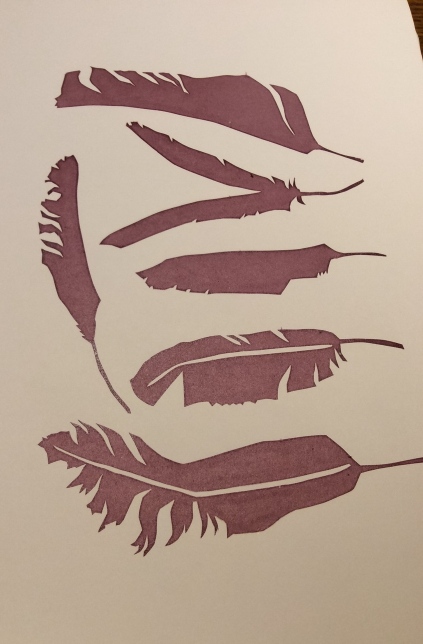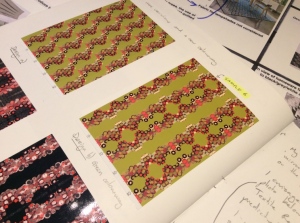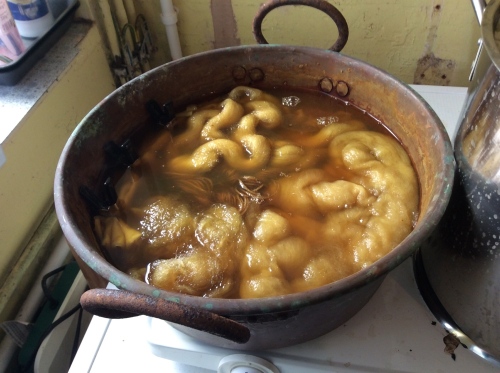18 November 2015
Stage 3 of Assignment 1 involves creating a portfolio and includes further drawings, development and creating of samples.
Stage 4 is about selecting designs for a specified outcome, one of which is a design idea to be developed towards a product. I decided to conduct an investigation of colour and trends in fashion and homeware alongside working my samples (it was also convenient for me to visit the University library at this time). I have therefore covered the investigative work for Stage 4 in this post.
At this time I also discovered cultural sensitivity in using certain designs, and in the way in which they are used. This influenced the direction of my development and which designs I chose to take forward.
Cultural sensitivities:
There are several well documented
cases
of native Americans
being offended by fashion houses using their designs and symbology. This extends not just to the whole scale copying of a design (for example the copying of an
Inuit shaman’s tunic), but also to the use of simple geometric shapes, such as
KTZ’s use of Crow symbology in their 2015 dress design. Offence can also be caused by combining symbology belonging to different tribes and cultures, which is seen as diluting the cultural identity, and being disrespectful. The Navajo Yei bi chai is considered particularly sacred.
Having read these articles, I decided that I did not want to further pursue the following themes:
1. Geometric shapes inspired by Arapaho dress
2. Navajo Yei bi chai
3. Designs inspired by bead patterns
I consider that my other themes are sufficiently abstract to be devoid of symbology and the risk of offence. This doesn’t mean that I would never develop these ideas, simply that I would first seek involvement and acceptance from the native people with which they are associated.
Trends in fashion:
I looked at both current clothing, and accessory fashion in magazines, and also I looked at a specific trend forecasting magazine. As suggested, I presented this research on a storyboard.
Three main areas I identified were:
1. The use of natural materials (faux or real), particularly suede and fur.
2. The trend for bold primary blocks, concentration on the waist and yokes. Contrast colours and fabrics.
3. Prints: contradicted shapes, intersections, chaotic lines and disjointed graphics.
4. Tassels and shaggy fringes (on everything from coats, dresses, jackets, bags). Particularly incorporating a shaggy dishevelled look.
My storyboard shows how these fashion trends have influenced some of my samples, and also the role played by cultural sensitivity in selection of designs.
The above photo shows the whole A1 storyboard. The two photos below show detail.
Trends in homeware:
I looked at both current homeware magazines, and also at a specific trend forecasting magazine.
The main areas I identified were:
1. A dominant colour palette of neutrals (beige, brown grey, black, white) with only the tiniest amount of accent colours (if any)
2. Plain glass lamp-fittings of LEDs (therefore fabric for lampshades was not considered)
3. Patterned fabrics to cover chairs/cushions working as accent pieces.
4. The use of bold geometric designs, particularly on rugs, throws and cushions.
My storyboard shows how these homeware trends have influenced my samples, and the role played by cultural sensitivity in selection of designs.
The above photo shows the whole A1 storyboard. The two photos below show detail.
Further development and sampling:
Feather mirror theme
In view of my knowledge of the colour trends in homeware, I took my feather designs and re-worked them in greyscale. I produced two fabric samples which could be used for upholstery.
Feather prints
I then made a pre-sample using a design I had developed from an enlargement of my feather prints. I used hand-dyed scrim and hand-spun textured yarn.
I simply ran out of time to work this into a full sample, but I think this design has lots of potential.
Sioux breastplate theme
I chose my favourite design from the photo manipulations of the paper breastplate model and sent it off to be made into a fabric sample. In view of the fashion of suede and neutrals, I chose the design with the chamois leather background.
I developed my fabric manipulation into a second sample. In view of the homeware colour trends I chose beige. I considered how this sample could be used on it’s own for a cushion cover or combined as part of a geometric pattern incorporating black squares.
Finally, I took the Sioux breastplate negative space analogy/block prints, and cut them into disrupted shapes and sewed them onto a new background.
Although the finished samples have plenty of movement and energy, I feel that the finished result is somewhat too busy/noisy (see photos below).
Feather and Sioux breastplate themes combined
I created two related hand-printed samples using foam print blocks and feather-shaped stencils. These are direct fabric analogies of my prints onto paper. I called this design “fallen feathers”. I thought that it would work well as a lampshade fabric, but having reviewed homeware trends, the fashion is very much for simple LED lighting or glass lampshade.
Blackfoot dress theme
I love the simplicity of this image and the many possibilities for digital manipulation. I tried out different colour variations and different ways of tiling the image. The range I explored is shown in my Design development book 1. I settled on a green and red colour way (complementary). The design is consistent with the fashion trend for disjoint and disrupted geometric pattern prints.
Geometric designs inspired by Arapaho dress
Not developed further due to cultural sensitivities.
Navajo Yei bi chai
Not developed further due to cultural sensitivities.
Ribbon appliqué
Not developed further due to deviation of native American theme.
Designs inspired by bead patterns
I did not do any further development due to cultural sensitivities. However I did get a fabric sample made from one of the design that I particularly liked (see bleow).
I was slightly disappointed that the colours on the fabric sample were not as vibrant as the digital image.
Snoshone Lake theme
This is the theme that I envisage being developed towards an artistic piece. I worked two sets of samples.
I first worked the stitched samples. I used by colour card and collaged analogies to inform the proportions of the sections which I chose to work and the threads and fabrics used.
Below: “horizon” stitched sample
Below: “grassland” stitched sample
I think both of the samples work, although I feel the grassland one is better.
I then worked two similar woven samples:
Below: “horizon” woven sample (work in progress)
Below: “grassland” woven sample

I really like both these samples. There is a lot more texture and movement in the woven “horizon” sample than it’s stitched counterpart. The woven “grassland” sample is stiffer and more regimented than it’s stitched equivalent due to the constraints of warp and weft being perpendicular.
Tassels and fringes
Not developed further due to lack of time. In hindsight this would have been an excellent theme to develop. Maybe I should have looked at trends earlier in the assignment.
















































